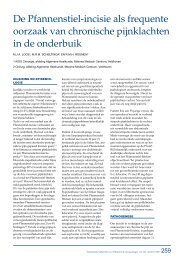Surgical management of chronic inguinal pain syndromes - Liespijn
Surgical management of chronic inguinal pain syndromes - Liespijn
Surgical management of chronic inguinal pain syndromes - Liespijn
You also want an ePaper? Increase the reach of your titles
YUMPU automatically turns print PDFs into web optimized ePapers that Google loves.
not attained in the remaining ten patients. In one patient meralgia paresthetica waspresent.Group II: Non-neuropathic <strong>pain</strong>Non-neuropathic causes <strong>of</strong> <strong>pain</strong> were detected in forty individuals. In 18 patients aperiostitis pubis was diagnosed. On examination their <strong>pain</strong> was clearly situated on thepubic tubercle, possibly as a result <strong>of</strong> an incorrectly positioned deep suture. Eightpatients with a suspected periostitis received an injection with lidocain and corticosn(%)Inguinal <strong>pain</strong> prior to surgery 132 (89.2)Postoperative <strong>inguinal</strong> <strong>pain</strong> comparable or worse 74 (50.0)Current VAS-score - Median (25-75%) 4.0 (2.5-5.5)*Time <strong>of</strong> onset after surgery - Median [range] 0 [0-60]Duration <strong>of</strong> <strong>pain</strong> - Median [range] 31 [3-300]FrequencyOccasionally 18 (12.2)Regularly 52 (35.1)Always 77 (52.0)Course <strong>of</strong> <strong>pain</strong> 85 (57.4)Intermittent 13 (8.8)Progressive 28 (18.9)Decreasing 21 (14.2)LocationGroin/ pubic region 134 (90.5)Scrotum/labium 24 (16.2)Medial thigh 25 (16.9)Lower abdomen 13 (8.8)Pain triggersErection 17 (13.2)Ejaculation 25 (19.4)Chronic <strong>pain</strong> <strong>syndromes</strong>** 47 (31.8)Working statusWorking 73 (49.3)Disabled (workers’ compensation) 40 (27.0)Retired 27 (18.2)None 7 (4.7)teroids in tissue overlying the <strong>pain</strong>ful periosteum for diagnostic purposes. All eightparticipants reported <strong>pain</strong> reduction <strong>of</strong> more than 50 per cent on their VAS-score. Aninjection was refused by ten patients, because <strong>of</strong> reasons described previously.Thirteen recurrences and one femoral hernia were diagnosed, some with the help <strong>of</strong>an ultrasound or CT-scan. Seven patients had a contralateral <strong>inguinal</strong> hernia as well. Inan eighteen-year-old soccer player bilateral adductor tendinitis was diagnosed. One 45-year-old woman with <strong>pain</strong>ful and limited hip endorotation suffered from an iliopectinealbursitis. She regained persistent full <strong>pain</strong>-free motion <strong>of</strong> the hip after an intrabursalinjection with lidocain and corticosteroids. Patients with ‘non-surgical’ problems includinghip osteoarthritis, referred lumbosacral <strong>pain</strong> and urological problems were referredto respective specialists (n=6) who confirmed these diagnoses at a later stage.Group III: Pain possibly related to spermatic cordForty-three patients (27.7 per cent) could not be identified on the basis <strong>of</strong> an existingclassification. These patients predominately described their <strong>pain</strong> as ‘aching’ in theabsence <strong>of</strong> a specific trigger point. The spermatic cord was <strong>of</strong>ten diffusely tender inthose patients who had undergone an anterior approach. Similarly, in selected casesthe inserted mesh during laparoscopic surgery produced a tight aching feeling in thelower abdomen, especially during exercise. In most cases no neurophysiologic abnormalitieswere present.Combining <strong>pain</strong> history, physical examination and additional tests 155 diagnoses couldbe made in 148 patients. In 7 patients a second cause for their <strong>pain</strong> was present:periostitis (n=5), hernia recurrence (n=1) and ipsilateral adductor tendinitis (n=1).n (%)Bulge 13 (8.8)Pain pressing pubic tubercle 18 (12.2)Trigger point 69 (46.6)NeurophysiologicalNormal 42 (28.4)Hypoesthesia 95 (64.2)Hyperesthesia 11 (7.4)Nerve block (Lidocain) 51 (34.5)Significant <strong>pain</strong> reduction* 41Periostal injection (Lidocain/ corticosteroids) 8 (5.4)Significant <strong>pain</strong> reduction** 8Table 2 Pain characteristics <strong>of</strong> postherniorrhaphy patients(n=148).Values between parentheses are percentages, unless otherwise specified. *VAS-score as measured at outpatient department.**Chronic <strong>pain</strong> <strong>syndromes</strong> = <strong>chronic</strong> headache, back <strong>pain</strong>, rheumatoid arthritis, fibromyalgia, irritable bowel syndrome.Table 3 Physical Examination and additional injections in patients with postherniorrhaphy <strong>pain</strong>(n=148).Values between parentheses are percentages, unless otherwise specified. *Significant <strong>pain</strong> reduction defined as >50% VASreduction after 10 min. **One patient with iliopectineal bursitis received an intrabursal injection with lidocain/ corticosteroids.70 Chapter 5Classifying postherniorrhaphy <strong>pain</strong> <strong>syndromes</strong> following elective groin hernia repair 71





